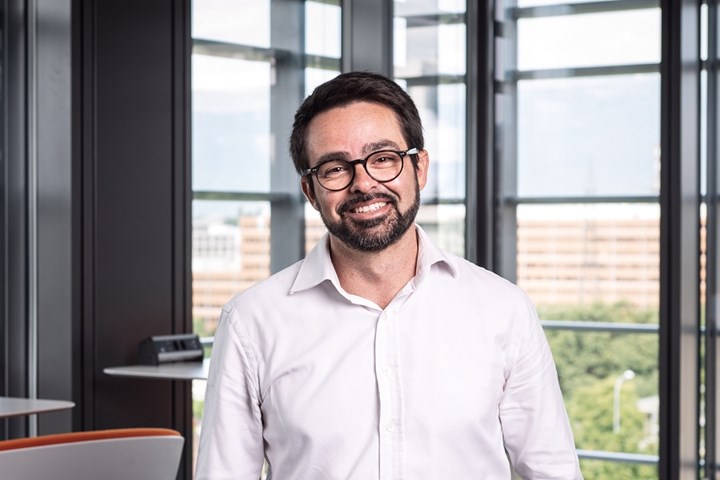Yann is CEO of the aircraft business of SITA Group with a mission to help the aviation industry achieve greater levels of sustainability and efficiency through the transformative power of technology and collaboration. SITA FOR AIRCRAFT serves around 300 airlines, 90 Air Navigation Service Providers (ANSPs), plus a host of manufacturers and maintenance organizations.
You’ve been in the air transport industry for 18 years. What still excites you most about working in aviation?
What's very special to me in aviation is the people and the fact that they've coped with – and thrived through – all the enormous changes that the travel sector has undergone over the years. Aviation has transformed itself from being an exclusive mode of transport in its early years—the glamor years – through to the growth years – making travel more accessible to all. And then, more recently, through everything that's happened during Covid and the recovery.
We've come through stronger, and you can see that the industry has a very special set of passionate people who strive for excellence, regardless of the challenging operating environment. That's what makes aviation – and here at SITA – special.
What is the biggest challenge for aviation today?
The biggest challenge is to keep aviation going without compromising the welfare of future generations and our planet. Aviation is a fundamental element of our society; we can't imagine our lives without it. Air travel is essential for trade, commerce, tourism, and overall economic growth.
So, the question we face is how can we, on top of optimizing airline operations, better manage the reduction of emissions and address the consequences of climate change? Take, for example, the increase in the occurrence of turbulence. Studies indicate that this is becoming increasingly frequent. And just the ability to manage that better now is a key challenge for the industry.
So, we need to work smarter to make our industry more efficient, sustainable and resilient.
How is SITA helping the industry to solve these challenges?
That's the question that cuts to the core of it. No single party doing something which is very clever in their own airspace, or their own airport, or their own part of the network – is going to be enough to make a global change. You need to bring different people together – dispatchers, airline pilots, flight planning, air traffic control – into one single unified system and that's where you indeed get those efficiencies. We make this easier because we can connect those airports, those air traffic control towers, and those pilots. That’s what SITA distinctively brings to solve these challenges. We're bringing all the stakeholders together, and we do this through collaborative, data-driven technology.
How does data specifically feature in this?
Data brings together of all stakeholders the air transport industry. This shared intelligence drives more informed decision-making.
But it requires some effort. Take the aircraft as an example. During flight, it’s often mission-critical to be able to access real-time data because it’s immediately actionable. That might come in the form of providing the flight crew with live data around changing weather conditions, or data that’s linked to engine performance which informs predictions of fuel burn while en-route.
At SITA, we first ensure safe and secure aircraft data communication, ensuring that our customers get the live data they need for all their needs and systems. We also use this real-time aircraft and complementary data in our products to facilitate timely decision-making.
AI and machine learning are a part of this landscape and can help us use data to model, predict, and glean insights. And when you can leverage real-time and historical data, trends, and machine learning, you can do things that bring long-term benefits. That's what we do at SITA, and that's where our technologies help.
Can you give an example?
With SITA OptiClimb®, for example, we are providing pilots with climb schedule recommendations to optimize fuel consumption. It’s a unique solution that uses machine learning to build a flight- and tail-specific performance model fed with 4D weather forecasts and operational flight plan inputs to compute optimum climb speeds and acceleration flight levels delivering fuel savings of up to 5% for each flight without compromising flight duration. We estimate that 5.6m tons of CO2 emissions could be avoided annually if all airlines worldwide use SITA OptiClimb® – we're talking about saving millions of dollars in operational costs.
SITA OptiClimb® is a compelling example of how new technologies are putting data to work for the airline industry in order to improve operational efficiency and sustainability.
What will be the biggest industry game changer in the next 10 years?
The economics of aviation will be changed by such factors as sustainable aviation fuel (which currently costs three to four times more than regular jet fuel), carbon offsets, and various kinds of regulations and varying fuel charges in different countries. There isn't yet a global and unified approach to all of this. Therefore, the question is, how will operators make business plans, given these new (but varying) rules and constraints, while still operating in a sustainable manner?
Aviation’s ability to adapt to the changing economic parameters of aviation, and the industry’s ability to operate in this new landscape successfully and with respect to the climate crisis, will definitely be a game-changer over the next decade.
How is SITA involved in integrating new air vehicles into aviation’s ecosystem?
We are actively working on many aspects of the ever-widening range of air space users, such as eVTOLs and drone delivery vehicles to make autonomous urban air mobility (UAM) a safe, scalable, and profitable proposition. At the start, these new vehicles will be segregated, but soon that traffic will be integrated into shared airspace, and that's going to change the way everybody operates.
To make UAM a working reality, we're focusing on the autonomous part, which can be achieved through technology. We've identified the core issues the industry needs to overcome, namely those of communications and coordination. They include inconsistent coverage in urban areas (which will cause comms and control gaps); network latency (delays in communications over a network will hinder the reaction times of eVTOLs within dynamically changing traffic); and using voice communications for remote coordination with air traffic (voice comms makes it difficult to scale and harmonize with other traffic). Now, we are actively developing a raft of solutions. These encompass consistent, reliable, and low latency networks for remote pilots to operate safely and with confidence. We're also working on a digital interface between the remote pilot and the controller for seamless, safe, efficient, and scalable operations.
And, of course, there’s a lot that we already do at SITA for commercial airlines today that actually would apply to those new urban aircraft and their operators going forward, like SITA OptiFlight®.
What benefits from the SITA OptiFlight® suite could be extended to these new vehicle entrants?
Optimizing fuel consumption during key flight phases like climb will be relevant to aviation's use of electricity or hydrogen in the future, just as its use of kerosene-based jet fuel is today. This will make the difference between a profitable and a non-profitable business because fuel costs, whatever the fuel source, will remain a significant proportion of an airline’s operating expenses.
And is there anything else on the horizon in development that you can tell us about?
Something we're working more on now is to optimize the approach of a given aircraft to an airport (known as the ‘descent’ phase). With newly available technologies and data, we're now much more capable of optimizing this phase of flight which will lead to further efficiencies.
I'm picking this example because there's already a lot of work that's happening on new aircraft and new engines which are obviously vital for the industry. But the ability to optimize what is already in service today is something our industry can start with already. We're not waiting for the next generation of Airbus or Boeing aircraft to enter service – we're already doing invaluable things today to optimize aviation's existing aircraft, systems, and infrastructures.







